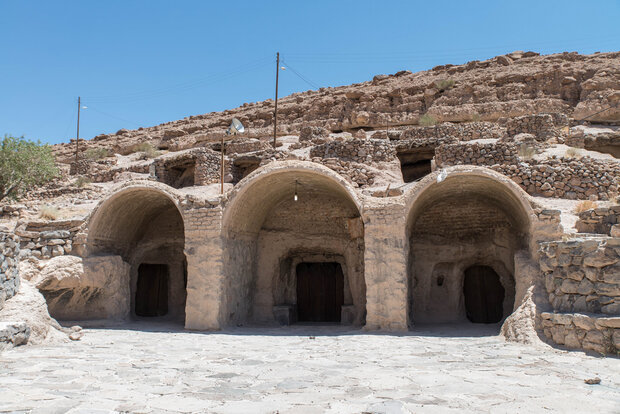
TEHRAN, (MNA) – At the south-eastern Iranian province of Kerman near Shahr-Babak city, there is a village dating back to the Stone Age. Meymand is a village of troglodytes – cave dwellers.
Meymand has been providing cozy caves and rock shelters for early inhabitants of the Iranian Plateau some 12,000 years ago. The settlement has been continuously inhabited since then, making it one of Iran’s oldest surviving villages.
The village is a UNESCO world heritage site, which won UNESCO’s 2005 Melina Mercouri International Prize. The purpose of the prize is to award outstanding examples of action in safeguarding and enhancing the world’s major cultural landscapes.
Meymand is located some 35 kilometers northeast of Shahr-e Babak, a city in Kerman province on the road that runs between Tehran in the north and the port of Bandar Abbas in the south.
Meymand is, for sure, one of the most spectacular villages of Iran.
Hand-dug houses are carved into a range of hills, beside the natural caves. They have been the residences of the local people since 3,000 years ago, and they are still in use. Compared to Kandovan, another troglodytic village in the country which has been inhabited for 700 years, Meymand is really ancient; it is, in fact, one of the oldest surviving villages as 10,000-year-old stone engravings and 6,000-year-old potteries were discovered.
Some 130 and 150 people are currently dwelling in the village many of whom are semi-nomadic shepherds, living in the village caves during the winter months when the population is at its peak. They move to higher pastures in summer, leaving about 60 people behind.
The villagers have done little to add color to the natural earth tones of the landscape. Their homes and streets have no potted flowers or ornamental plants. The village’s stark appearance is complemented by the spartan life of its inhabitants.
here is a 400 sq meter complex of 15 circular rooms in the village. Bones and personal belongings, discovered in the complex, suggest that the place might have been a crypt or a series of ossuaries.
The area seems to be a place of burial, as skeleton bones and other articles have been found here. The ancient houses in this rural settlement resemble minarets constructed in the breast of this hard stone mountains.

The stone mosque of Meymand is another interesting site in this village. In these minaret shaped dwellings, which are very strong and durable, there are chambers, corridors, and pillars displaying an intriguing architecture.
Rock art can be found in and around Maymand. Three kilometers northeast of Meymand, beside a gravel road that runs towards the Tela valley, lies a hill called Mar Khazineh (Mar in the local dialect means hill). A 350-meter climb down the hill brings us to an ossuary plot filled with the scattered pieces of destroyed ossuaries decorated with rock art. Locals say that these and other ossuaries are from the Zoroastrian-Sassanian era.
There are a total of 406 residential cave units with a total of 2,560 rooms. Some of the cave apartments are five stories high. A large number of the units are deserted.
The dwelling units were made by burrowing into the hillside’s soft sedimentary rock deposited in layers during the Mesozoic age some 100 to 200 million years ago. The concrete-like consistency of Meymand’s sedimentary rock is soft enough to be shaped by manual labor while still being hard enough to support the roofs of the cave units.
Some lower cave dwellings are grouped together. Their entrance trenches meet on a terrace used for family and social gatherings.
There is also an eight-room guest house near the entrance to the village, but visitors can sometimes find lodgings with some of the residents. The guesthouse has felt carpets on the floors, beds carved into the walls, warm lighting, and shared but clean bathrooms with steam showers. A step into the house and one is sucked far into history.

No comments:
Post a Comment